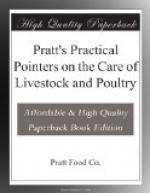Prices of really desirable horses are now high. If you have a good one, take good care of him. Protect his health, lengthen his life. If you must buy, be sure that you get a sound animal which will serve you long and faithfully.
See the horse in his stall. If he has a spavin he will hop on one leg when made to “get over,” or jerk it up as he backs out if he is affected with chorea (St. Vitus’ dance). In the latter disease the tail is suddenly raised and quivers when the animal backs out of stall. Watch to see if the horse “cribs” and “sucks wind”: also that he is not vicious in the stall. Stand him at rest on a level floor before exercise. If he is lame he will rest the sore foot.
Examine both sides of the horse. The dealer may stand the “bad side” next to a wall. Pick up each foot in turn. Suspect something wrong if he wears bar shoes, special shape shoes, leather soles or rubber pads. Remove all such things and examine carefully before buying.
[Illustration: PERCHERON HORSE]
-------------------------------------------------------
---------- Englewood, Colo.
I have had many
dealings with rundown horses, both in the draft
and hot blood
classes, and Pratts goods have always brought them
out on top.
JAS. S. KINSLEY, JR._ ------------------------------------------------------------
-----
Reject for contracted feet, steep heels, shrunken frogs and bars, dropped soles, corns, quarter cracks and signs of founder. See that hoof dressing does not cover evidences of un-soundness. Following bad attacks of founder the hoof grows out long at the toes, shows marked grooves and ridges, is convex at the points of the frogs, and the horse tends to thrust his forefeet out in front when standing and walks and trots on his heels. Ringbones are indicated by hard bony enlargements on the pastern; side-bones, by similar enlargements at the quarters just above juncture of horn and hair. Examine front of knees for scars indicating results of stumbling and falling. Similar scars on the inside of knees and fetlocks indicate objectionable cutting and interfering. Shoulders and hips should be smooth, well covered, and free from tumors or sores. No sores should be seen on back or top of neck under collar.
Examine teeth for age and soundness. See that eyes are of like color, are sound, and the eyelids whole.
The horse should allow one to examine his ears, and should neither hold them absolutely still nor keep them constantly moving. Still ears may indicate deafness; restless ones, poor eyesight or nervousness.
See that the horse goes sound and does not “roar” when galloped. Give him all the water he will drink before testing for “wind.” It will bring out the characteristic symptoms of “heaves” if he has been “doped.” Heaves is indicated by labored bellows-like action of the abdominal muscles when breathing. Examine the nostrils, as sponges or squeezed lemons may have been inserted to hide roaring.




